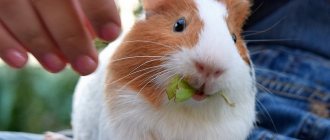Fenechs' natural habitat is the deserts of North Africa, but due to their tiny size, they are an excellent alternative to small dog breeds suitable for apartments. The fennec fox at the withers has a height of 18 to 22 cm, a body length of 30 to 40 cm, and a body weight of up to 1.5 kg. The tail of this little fox is almost equal in length to the body - approximately 30 cm, which is covered with fluffy fur.
Fennec fox - who is it?
The fennec fox is probably the most amazing representative of the genus of foxes in the canine family.
The name "Fennec" translates as "fox" (Arabic word fanak). However, the scientific name of this animal is Vulpes zerda, which literally means “dry fox.” This gives a clue as to the fennec's habitat. These animals live in the deserts of the Arabian Peninsula and North Africa.
Scientists are still arguing about whether the fennec cat can be called a fox. After all, the behavior and structure of the fennec fox differs from other types of foxes. Even the number of chromosomes is different: the fennec fox has 32 pairs of chromosomes, while other fox species have 35 to 39. The fennec fox does not have the musk glands characteristic of a fox. And unlike foxes, which live alone, the fennec fox is a social animal. Therefore, a number of scientists have identified the fennec tree as a separate genus “Fennecus”.
In the photo: fennec
Convenient purchase of exotic animals
We offer everyone a wide variety of animals directly from their nursery. Fenech is no exception, and now with our help a resident of any region of Russia can order them. The cost is discussed with the client individually and depends on the characteristics of a particular individual. Our managers can answer any questions you may have and provide certificates for each animal. We do not have foxes that were caught in the deserts only to be sold to our compatriots. Here is a catalog of domesticated animals that were specially bred for sale, and all the necessary documents are always attached to them. Call right now and order!
What does fennec look like?
The fennec fox is a small animal, a fox, smaller in size than a domestic cat. The height at the withers of the fennec is from 18 to 22 cm, the body length is from 30 to 40 cm, the tail reaches a length of 30 cm. The fennec weighs no more than 1.5 kg.
The fennec muzzle is pointed and short. The eyes of this fox are quite large.
The fennec cat's ears are its distinctive feature. The fennec fox has the largest ears relative to the size of its head among predators - the fennec's ears can reach a length of 15 cm. Such ears are not a luxury; the animal is forced to catch the slightest rustle in order not to miss its prey - small animals and insects. In addition, the fennec's large ears are excellent for thermoregulation and remove excess heat from the little fox's body, which is necessary in a desert climate.
The fennec's feet are covered with fur, and thanks to this, the animal runs across the hot desert sands silently and easily.
Fennec cats have small teeth.
The fennec cat's fur is soft and thick.
The fennec's color allows it to blend in with the sand: the fennec's fur is fawn or reddish on top, and white below. The young fennec fox is almost white. The tip of the fluffy tail is black.
Like other wild foxes, the fennec fox does not have sweat glands.
The fennec fox can endure thirst for a long time if it is possible to obtain liquid from food. Fennec's kidneys work in such a way that they do not allow dehydration for a long time.
In nature, the fenech chooses sparse bushes or thickets of grass, where it finds both food and shelter. The fennec lives in a hole, which is equipped with many secret passages.
In the photo: fennec
Fenechs form family groups (up to 10 animals). However, they go out hunting one at a time.
The fennec fox jumps well: up to 120 cm forward and up to 70 cm up.
Fennec at home: pros and cons
From the above description and characteristics of the fennec, we can draw a conclusion as to what advantages and disadvantages are inherent in this animal.
Let's start with the pros:
- Decorative and exotic look.
- The animal is active and playful.
- Easy to care for.
- Not picky about food.
- Gets along easily with cats and dogs.
- With proper maintenance they live a long time (up to 15 years).
Among the disadvantages are the following:
- The high cost of the animal and high costs at the initial stage (cage and toys).
- It will take a lot of time and effort to tame an animal.
- They mark the territory.
- They don't sleep at night.
- They love to throw things around.
- It is very difficult to find a doctor for fennec cats.
- They can be aggressive; You cannot have such an animal if there are small children in the house.
Can we say that the house fennec is an interesting pet?
If you create good conditions for the fenech, he can become a rather interesting pet, smart and affectionate. However, keeping a fennec cat at home is quite difficult, since it is still a wild animal and not a pet.
Success in taming a fennec cat depends on the age at which it came to you. It is best to purchase a fennec cat at the age of 6 - 9 months (before puberty).
At first, give your pet maximum attention, communicate with him and feed him by hand. However, avoid sudden movements and loud sounds - the fennec fox is very sensitive and timid.
In the photo: house fennec
Reproduction
Fennecs breed once a year. The mating season is in January–February, but the females' estrus lasts only two days. These animals are monogamous, each pair has a home range. During the breeding season, males become aggressive and actively mark their territory with urine.
Pregnancy lasts 50–53 days; in March–April, the female gives birth to 2–6 cubs in a burrow with a nesting chamber lined with grass, feathers and wool. Puppies weigh only 50 g at birth. The mother remains with them in the den until they are two weeks old, when their eyes open. The male brings food, but does not enter the den, because the female is very aggressive at this time and drives him away from the puppies. At the age of 5 weeks, the cubs first leave the den and wander around the surrounding area, but only at the age of 3 months do they begin to travel significant distances. At the same time, females stop lactation.
Fennec cats reach sexual maturity at 6–9 months. Sometimes young fennec cats stay with their parents and help raise new offspring. Life expectancy is 10–12 years.
How does Fenech behave at home?
A tame fennec at home behaves friendly, playful and inquisitive. The fennec fox loves to sleep next to its owner or sit in his arms.
At home, the fennec fox is a very active animal; it searches for something almost all the time, runs around, and can easily jump onto a bedside table, sofa or computer desk. So it’s better not to leave a cup of tea or coffee near your laptop!
Fenech is very talkative: he whines, snorts, barks, grumbles and howls. Moreover, it voices not only during the day, but also at night - you need to know about this before getting such a pet.
The fennec fox won't refuse to play pranks either. For example, if he finds a bag of sugar or cereal, he will be delighted and instantly take the contents to every corner.
Please also note that all electrical wires will have to be hidden - the fenech likes to chew on them.
In the photo: fennec at home
Behavior, temperament of a fox
The character of Fennecs is a peculiar combination of the characters of a cat and a dog. They are energetic and playful like little dogs. But at the same time, they are independent, graceful and a little selfish, like a cat.
Gender differences are also interesting: boys are usually calmer and more obedient than girls. Females are more active, nimble, but shy. Sterilization does not affect their character (only the smell of urine changes). And castration of a boy makes him even calmer and more affectionate.
Relationships with people and animals
Fennec foxes became pets for a reason - miniature creatures love to play with humans and completely trust them. Over time, the owner begins to understand the mood and desires of the pet: the fox can whine, snort, yelp, growl and even howl.
In order for her to become truly domestic, you need to devote a lot of time: communicating, petting, playing. A pet is not suitable for people who spend all day at work, or go on a long vacation or business trip. During his absence, the animal will easily forget both its owner and all the “cultural skills” it has learned, and will become a “savage” again.
Usually Fenechs do not single out one owner - they are good-natured towards all family members. However, they may dislike certain people for reasons only known to them. Some foxes are suspicious of strangers and hide from them. “Yummy food,” communication in a calm voice, unobtrusive play, and affection will help you win over the animal.
Foxes are not as predictable as dogs and cats. Therefore, it should not be started in families with small children.
It is dangerous to leave a child alone with a fox cub - if the baby handles the pet carelessly, it can scratch or bite it
The beast is able to make friends with almost any animal except the species that it feeds on in the wild. Fenech will become the best friend of a dog or cat, especially if they grow and mature together. But friendship with birds, hamsters, chinchillas and other rodents will not work. The fox perceives these pets as potential food.
https://youtube.com/watch?v=QPcJ8gRDoZ8
Behavior at home
Fenechs are not bored in the apartment: they constantly run around the room, looking for something, digging up something. There are no barriers: the fox deftly jumps on tables, doors, cabinets and window sills. This feature of animals must be taken into account when purchasing: if a person values the environment at home, it is still worth getting a calmer pet.
Fenechs are not just fast - they are swift creatures whose movements cannot be followed by humans.
Therefore, people need to be careful not to step on their pet or pin it in the door. It is not difficult for a tiny fox to inflict serious injury through negligence.
It is not recommended to leave an animal alone in an apartment: there is a high probability that it will turn the whole house upside down. Be sure to hide fragile, breakable things, close the toilet lid and the restroom itself, the bathroom. An animal may like upholstered furniture so much that when the owner arrives, he will dig a hole in it.
Plastic bags, small, sharp objects, and live wires also attract foxes. Therefore, in order to avoid accidents, he is kept either in an enclosure or in a separate room, away from dangerous things.
Noise
The future owner should remember that the desert fox is very talkative - yelps, “purrs”, and snorts. In a good mood, Fenechs make beautiful sounds, similar to bird trills. They bark in response to different situations: loneliness, a walk, an interesting subject.
If a fox is bored or lonely, he begins to howl pitifully, whine, and grumble. These pets express the joy of the owner’s arrival and a fun game with a loud squeal. Many foxes develop “signature greetings” for each family member.
Some representatives are not averse to having “night conversations.” Therefore, they are placed to live in a separate room or enclosure.
How does the fennec fox get along with other animals and with children?
Some owners say that a fennec cat and a cat can easily become friends and even play together. However, small animals can provoke aggression in the fennec fox. In addition, when living together with other animals, you need to take into account the timidity of the fennec fox. You should not stress your existing animals and your new pet if you are not sure that they will get along.
And no matter how much effort you make to tame a fennec cat, it is still not a dog. So you shouldn’t bring a fennec into a family with small children.
Little fox's personal corner
The biological hours of activity of the owner and the animal do not coincide, and therefore a separate room or corner should be allocated to the fenech away from the bedroom. A very significant point in caring for an eared fox is the temperature regime. It is important that the room is warm, otherwise the fennec may get sick. This can be a serious problem, since this domestic fox gets sick for a long time and seriously, and it is not so easy to find a veterinarian who knows how to treat such pets.
The animal loves to dig, so it would be nice to build a play area for it, where you can pour sand. If this is not organized, the nimble fenech will be left to build tunnels in furniture and things. Therefore, providing the animal with leisure is solely in the interests of the owner. The safety of your pet is of no small importance, because excessive curiosity and mobility are ready to play a cruel joke on him. Be sure to close doors and windows and hide fragile items. There should be no wires in the access area, which the little fox will certainly be interested in.
In order to prevent troubles, it is advisable to properly equip the cage/enclosure and let it out for walks around the apartment only under the supervision of the owner. Of course, everything noted above requires additional expenses, but your home will be in complete order, and you will be able to go about your business without worry, without thinking about what your pet has done.
Is it possible to walk with a fennec cat?
If you train your fennec cat to take walks, he will be happy to keep you company. However, do not forget that the fennec fox is a heat-loving and gentle animal, for which hypothermia can be deadly. Therefore, in cold autumn, winter and the first half of spring, it is better to refrain from walking with a fennec.
It is better to lead a fennec cat not in a collar, but on a harness. A fennec fox can wriggle out of a collar and run away, and in addition, any accidental, even weak, tug on the leash in this case can cause injury to the cervical spine or larynx.
When walking with a fennec cat, you will have to be vigilant - oncoming dogs may show aggression.
It is better to walk with the fennec early in the morning and late in the evening - this way you will be in unison with the natural biorhythm of the fox.
In the photo: fennec fox
How is a domestic fox different from a domesticated one?
A domesticated fox puppy will cost less, but we would not recommend chasing cheapness. This is not the case when you need to save money. The domestic fox is tame, not aggressive, and amenable to training. These foxes need a person, yearn for him and are greedy for affection. In a word, this animal is very reminiscent of a dog, some of them also wag their tail and whine from impatience or an influx of feelings.
A domesticated fox is a pig in a poke. She may well turn out to be close to a domestic one in terms of her set of personal qualities, but she may not favor the person too much and give free rein to her instincts. There have been cases when foxes broke loose and severely bit their owners or their guests. In addition, foxes that have retained the tendencies characteristic of their wild relatives may have a tendency to scream at night and “run across the ceiling” and constantly mark their territory. And fox urine is extremely smelly and corrosive.
Keeping fennec at home
There is an opinion that the fennec fox is the only representative of the fox genus that can be kept at home. But a breed of domestic foxes has already been bred, which also live in families.
Nevertheless, it is the keeping of fennec at home, although it has not yet become commonplace, that is gaining more and more popularity. However, is it easy to keep a fennec fox at home?
The domestic fennec fox is not as easy an animal to keep as some people think.
First of all, fennec is a nocturnal animal. This means that he is awake while we are sleeping, running around and making noise, causing a lot of anxiety.
Secondly, the fennec is neither a dog nor a cat; it is not easy to train him and it is not always easy to accustom him to a diaper or litter box. At the same time, the fennec fox does not smell like violets.
Thirdly, the fennec will not live in a cramped cage. He needs an enclosure or a separate room (and it must be heated).
The floor in the room where the fennec fox lives should be covered with sand or blankets should be provided for the pet’s use so that the animal can dig holes and bury itself.
You will have to maintain a temperature of +20 degrees or higher. If it gets colder, the fennec will quickly catch a cold. And a fennec cold often ends in death.
In addition, it must be taken into account that only a few veterinarians are willing to advise on the health of exotic animals such as the fennec fox. And it is very likely that if your pet gets sick, you will have no one to turn to for help.
Therefore, before deciding to keep a fennec fox at home, you should once again weigh the pros and cons.
In the photo: fennec fox
Animal care
A person should spend a lot of time raising a Fenech. But caring for a fox is completely simple - no more difficult than caring for a dog or cat.
Grooming
Domestic foxes, although considered exotic, are very undemanding. Their thick fluffy fur does not require trimming or styling at a grooming salon.
The pet does an excellent job of hygiene on its own. However, in order to avoid tangles, the owner also needs to periodically comb the fur. If the animal is very dirty, it is bathed with dog shampoo and, if necessary, dried with a hairdryer.
Foxes naturally have long claws. To prevent the pet from damaging the furniture or injuring a person, they are trimmed: on their own or at the veterinarian.
Walks
Active Fenechs love walks in the fresh air. Therefore, they will be very happy in a country house with a large garden plot. Don’t mind taking a walk on the lawn, in a quiet park, or a forest belt. But this requires a leash or harness.
Since the long-eared fox is a southern creature, walks are organized in the warm season. In winter, the animal is kept indoors, protected from drafts and low temperatures. Fenechs love to travel in the car: they calmly look around or sleep curled up. But they don’t like closed spaces like baby carriers.
Nutrition
Feeding Fenech is not similar to the diet of indoor dogs:
- Meat (fresh, lean): lamb, chicken, beef, rabbit.
- Insects: locusts, mealworms, large beetles.
- Rodents: mice.
- Small reptiles, lizards.
- Eggs: quail.
- Fish. The product must be pitted and thermally treated: boiled or frozen.
- Boiled vegetables (no more than 2 teaspoons per day). Foxes cannot tolerate carrots, grains, or corn.
- Raw fruits, berries, cut into small pieces. Foxes love figs, cherries and dates.
In nature, Fenech's diet is: 90% animal food, 10% plant food. These proportions are also observed for domestic foxes. If it is difficult for the owner to provide the animal with a natural diet, he switches the animal to complex feeds: Nature's Variety, Innova, Felidae, Solid Gold, Eagle Pack Holistic, Azmira.
Toilet
The toilet issue can be easily resolved: a fox can be trained to relieve itself in a litter tray or in a special diaper. If an animal is purchased from a nursery, it already knows how to go to the toilet in a strictly designated place.
Most often, Fenechs are kept in enclosures and separate rooms. In a permanent place, in a limited space, it is easier for them to decide on a place to relieve themselves than in a large human house.
What to feed your fennec cat?
Many potential owners are wondering “what to feed a fennec cat at home.” To find the answer, you need to consider that in natural conditions the fennec fox is almost omnivorous. Fenech feeds on insects, small vertebrates, bird eggs, fruits and roots of plants, and does not disdain carrion.
So at home, the diet of a fennec fox is similar to that of a small dog.
Fenech can be fed:
- Meat (lamb, rabbit, veal, chicken).
- Fish (boneless, boiled).
- Vegetables (boiled).
- Fruits (raw).
Behavior and nutrition
Fennec inhabits sandy deserts, where it prefers to stay in thickets of grass and sparse bushes, which provide it with shelter and food. He lives in holes with a large number of secret passages, which he digs himself; leads a nocturnal lifestyle.
Fennec foxes are social animals; they live in family groups, the number of individuals in which reaches up to 10. Clans usually consist of one married couple, their immature offspring and, possibly, several older children. Sometimes several families settle together in one den. Fennec cats mark the boundaries of their home range with urine and feces. They are very “talkative”: they bark, whine, grumble and howl.
- Dog
- Long-eared cats
- Cat meowing
- Alexandrian parrot
- Why does a cat need a mustache?
- Rescue dogs
Fenech is omnivorous and digs most of its food from sand and soil. He prefers to hunt alone, like all foxes. Fenech feeds on small vertebrates, eggs, insects (including locusts), carrion, plant roots and fruits. Huge ears allow him to catch the slightest rustle made by his victims. It can go without water for a long time, obtaining liquid from meat, berries and leaves. Stocks food supplies.
Fenech exhibits great agility and liveliness, the ability to jump high and far - up to 0.7 m up. Its protective coloring allows it to blend into the sandy landscape; There is no evidence that larger predators prey on fennec foxes. He has a well-developed sense of smell, hearing and good night vision.
How much does a fennec fox cost?
The fennec fox is a rare animal, so its cost is quite high. In Russia, a homemade fennec tree costs 65–200 thousand rubles.
And even despite the high cost, it is not easy to buy a fennec both in Belarus and in Russia, so these animals are often brought from America or Western Europe. But if you choose this option, be careful and use the services of a specialist: you need to know the rules for the export and import of such animals, prepare the necessary package of documents and make sure that the fennec fox is healthy.
However, purchasing a fennec fox is only a small part of the cost of owning a fennec fox. It is necessary to create conditions for the pet that are close to natural. Otherwise, your furniture and other property will suffer, and living together with a fennec cat will turn into a living hell for both you and the animal.
In the photo: fennec fox
Price
Not every family can afford these animals. The cost of one animal ranges from 10,000 to 50,000 thousand rubles . Moreover, females are valued much higher due to their ability to give birth to young.
It won't take much money for Fox's living expenses. The animal quickly tames to the tray, finds a common language with people and animals and practically does not neglect any food. However, remember that the fennec is a nocturnal animal. To avoid having to spend money on buying new furniture or interior items, give the animal an enclosure or room so that it can show its hunting instincts there.
Fenech: interesting facts
- The most famous fennec fox is the same fox from “The Little Prince” by Antoine de Saint-Exupéry. It is he who owns the phrases “You are responsible for those you have tamed” and “Only the heart is vigilant - you cannot see the most important thing with your eyes.”
- In Algeria, the fennec fox is revered, where the fennec fox is the national animal. Even the football team of this country is called “Fennecs”. In addition, the image of a fennec fox adorns the Algerian ¼ dinar coin.
- The fennec fox also symbolizes the ecology of Tunisia, and in every city you will find an image of a fennec fox dressed in blue and white.
- Fennec is the codename and logo of Firefox for mobile.
- The popularity of the fennec cat as a pet jumped sharply after the appearance of the cartoon Zootopia.
- Mentions of the fennec are found in the following works:
- Mine Reid "Young Hunters" (although there is no fennec fox in Kalhari).
- Henri Troyat "The Crash" and "City of Lions".
- Antoine de Saint-Exupéry "Planet of Men".
- Felix Krivin "Fennec Fox".
- Sergey Lukyanenko “Transparent stained glass windows”.
- Frank Herbert "Dune".
In the photo: fennec
What should you teach a fox to do first?
- Accustoming to a crate (the puppy must understand that this is his space, his hole. It is better to select large crates, approximately 3000x1000x1200 mm.);
- Toilet training (at first, trays should be placed in all rooms and the contents in them should be promptly changed;
- Reconciliation with the muzzle (almost none of the foxes like it, but if you get used to it right away, it will be easier. You can’t walk in the city without a muzzle);
- Washing, combing and trimming claws (important procedures, most foxes take them calmly, but there are also those who do not like beauty treatments; those accustomed from childhood tolerate “execution” more calmly);
- Weaning off biting (we need to strictly and clearly make it clear that we don’t let our teeth loose at home);
- Interaction with owners and strangers (everything is approximately the same as with dogs);
- Lack of fear of noise and other animals (gradually and affection).











